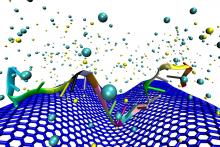
Graphene-based biosensors could usher in an era of liquid biopsy, detecting DNA cancer markers circulating in a patient’s blood or serum. But current designs need a lot of DNA. In a new study, crumpling graphene makes it more than ten thousand times more sensitive to DNA by creating electrical “hot spots,” researchers at the University of Illinois at Urbana-Champaign found.


